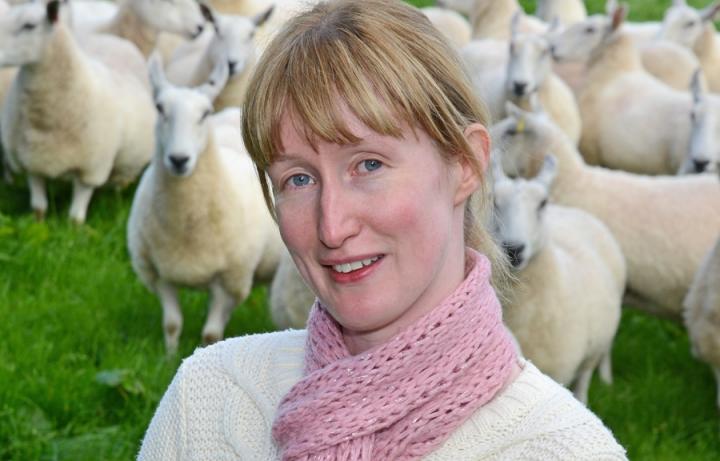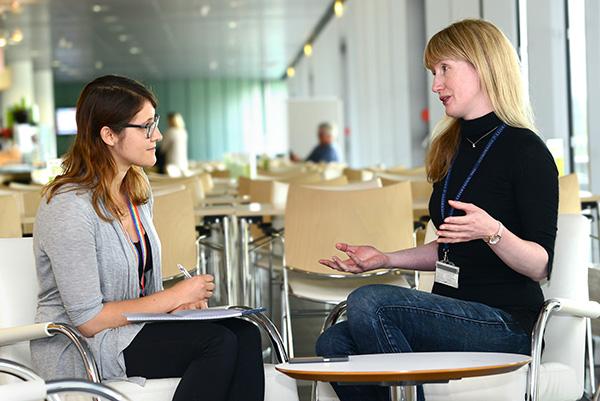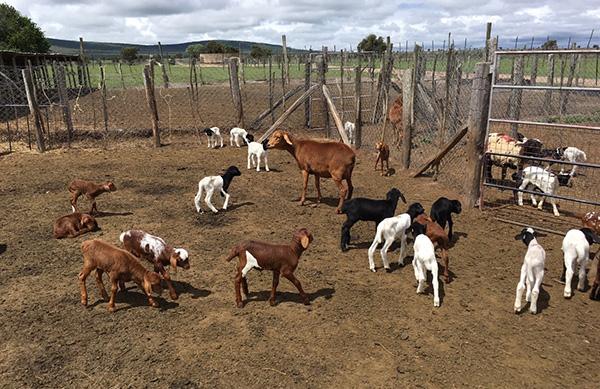Dr Emily Clark on genes with a function
The genetics of tropical adaptation, advances in genome sequencing, colourful lambs and her love of animals.

Dr Emily Clark is a Chancellor's Fellow working in livestock functional genomics at The Roslin Institute who loves working with animals. In this interview, she talks with Science Communication Intern Maggie Szymanska about how she investigates the genes of farm animals to understand how they control immunity, productivity and adaptation to the environment.
Could you tell me about your research in a nutshell?
I work on functional genomics in livestock, predominantly looking at how genes are expressed (i.e. switched on and off) in livestock. When I first joined The Roslin Institute, I led the sheep gene expression atlas project, which was a large project that looked at gene expression in all tissues and cell types in sheep.
We collected tissues from all the major organ systems at multiple stages of development, such as embryos, foetuses and lambs. This allowed us to look at the expression of genes in many different ways. For example, we looked closely at genes expressed during the development of the rumen because these genes might be influencing methane production and greenhouse gas emissions.
The research my group does, by analysing gene expression using our large sheep gene expression atlas and our smaller goat atlas helps to improve the annotation of the genomes of livestock species.
We add 'notes' to the genome sequence to tell us where genes are and what they are doing. This helps to lay a foundation for researchers working in livestock genetics and genomics and animal breeders to use the genome of sheep and goats to answer important questions about which genes are involved in disease resistance or fertility for example.
What's your current role at the Institute?
Recently, I started a Fellowship that integrates the sheep and goat gene expression atlas projects with research on small ruminants from African countries, including Ethiopia and Cameroon, working within the Centre for Tropical Livestock Genetics and Health.
Part of my work focuses on looking at all the genetic information, for African small ruminants, we have currently and how we can use it to determine how small ruminants are adapted to tropical environments. The ultimate goal is to identify genes that drive specific adaptations to a tropical environment, including resistance to tropical diseases or tolerance to drought.
One of our projects looks at resistance to trypanosomes, which are parasites that cause sleeping sickness, in populations of sheep from Cameroon.
How did you become interested in this field of research?
I had always been interested in livestock and I really enjoy working with animals in general. My undergraduate degree was in Animal Biology and for my PhD I used molecular phylogenetics to characterise the bacterial symbionts of insects.
I knew that I wanted to return to more animal-based research once I completed my PhD. I then spent a few years working on Eimeria parasites in poultry at the Royal Veterinary College before the opportunity to work on the sheep atlas project was advertised. I immediately knew I wanted to apply because it involved working on a larger animal, which was what I really wanted to do.
What's the importance of this work?
Sheep are a hugely important livestock species globally, providing a key source of meat, milk and fibre. Sheep and goats, in low and middle income countries, represent a key route out of poverty, particularly for women and girls.

The genetic and genomic resources we have for sheep and goats are however of nowhere near the scope and scale as we have for humans, or even cattle. This can limit the usefulness of the information we do have for improving breeding and productivity. This is particularly true in tropical systems where the diversity of sheep and goats and mixing of populations makes unravelling the underlying genetics quite complex.
When I first started doing research, our knowledge on livestock genomes was not even close to our knowledge on the human genome, so that really inspired me to work in this field. The genetic resources for livestock are so much better now, we can do so much and hopefully we are helping to lay a foundation that can help provide information for others to build on e.g. for breeding, for biomedical models and other broader applications.
It's amazing how much all the techniques and resources have evolved, there is so much we can do now!
Yes, definitely! The cost of sequencing has come down so much as well. Even within the time I was working on the sheep atlas project, the cost of the technique we use for measuring gene expression, called RNA-Sequencing, was really decreasing each year, which allowed us to do so much more with the grant we received and meant we could generate a lot more information!
How do you see the future of your research?
That's an interesting question! It definitely depends a lot on the funding we'll receive, but I think the future of the research I am doing at the moment will be to continue developing tools that can be applied to livestock in tropical countries. Hopefully this will help to improve sustainability and to inform breeding in tropical countries.
I really hope that we can bring small ruminants up to the same level as other livestock animals, such as cattle, in terms of the genetic tools that are available.
We were lucky and received some funding from the Global Challenges Research Fund, which gave us the opportunity to generate hundreds of genomes of sheep from Ethiopia, and Cameroon, and goats from more than fifty different African countries. I want to link the information we have from the sheep gene expression atlas to the genomes of these sheep, so we can identify specific types of genes related to adaptation to a tropical environment. The research is really progressing in that direction.
I would also like to apply what I am doing to animal breeding, using functional annotation to inform genomic prediction. Then animal breeders, using genomic prediction algorithms, can put more emphasis on relevant parts of the genome.
Could you tell me about some challenges you have experienced working as a scientist?
There are definitely many challenges. The biggest challenge when I started was that the annotation of livestock genomes wasn't very detailed, in comparison with humans. Luckily this has changed in the past five years, hopefully also due to our work, I think we managed to contribute to mitigating that challenge, especially with the creation of the sheep gene expression atlas.
I also remember when we first started the goat genome project we had trouble mapping the data to the old version of the goat genome. Then, last year, a new assembly for goat came out and that really changed everything for that project. That was one of the challenges that we managed to overcome.
There are also challenges associated with dealing with large datasets. The sheep atlas is huge and multidimensional, there are different developmental stages, different tissues and different individuals. This can cause many complexities in how we analyse it. In a way, you could call it a 'big data' project.
The problem with big data is, as the name suggests, it is just so big! You can analyse it in so many different ways and it was a challenge to achieve clarity in the analysis. With the size of the dataset, I could probably be analysing it for the rest of my life and still not investigate everything!
Managing everything linked to the Sheep Atlas project was also a challenge during the first year. We were collecting tissues from the sheep so I had to organise a large group of people, various trips to the farm, checking that the sheep were in the developmental periods we needed them to be in and just making sure everything was running smoothly and working well. That particular project was definitely a bit of a challenge, but it was also very good and rewarding at the same time.

Do you have a favourite story from your projects?
I travelled to Nairobi in Kenya last May for a meeting and I was lucky enough to go up to the Kapiti ranch, which is run by the International Livestock Research Institute and is home to a managed flock of Red Maasai and Dorper sheep. These sheep are part of an improvement program and they are crossbred for this purpose.
When we were there, they were lambing and all the lambs were differently coloured and they were really lovely. The Dorper sheep are black and white and the Red Maasai are chestnut coloured, so the lambs were all different combinations of these two colours! They were all in a pen outside of the research breeding station and it was just really nice to see them out in the field. That was definitely one of my favourite stories recently.
Why did you decide to become a scientist?
When I was a younger I wanted to be a vet for many years and I ended up studying animal biology. I always wanted to work with animals and was interested in physiology and genetics. I have horses and have always been interested in farming and agriculture. This job gave me the ideal combination of science and livestock.
And finally, if you weren't a scientist, what would you be?
I think I would probably be a vet or a farmer ‒ I'd be definitely still working with animals! I just really like being outside and looking after them, so I think that's what I would do.
Related links
Sheep gene insights could help farmers breed healthier animals
Award winning Scottish research could pave the way for ‘low-emission cattle’
New Gene ATLAS to facilitate search within UK Biobank


